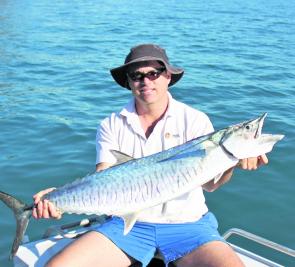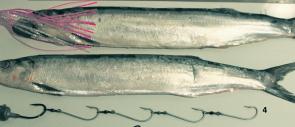Cold weather and southwesterly winds can only mean one thing around here – red hot pelagic fishing. July is one of the best months of the year to target mackerel in the waters around Bowen and with strong early season captures already recorded, this year should prove to be a good one.
The best way to capture a big Spanish mackerel in Bowen waters is to put the lures and bait out the back and troll. Although hard body lures, skirts and metals are all viable options, taking the time to rig a big dead bait such as a wolf herring will greatly improve your capture rate. Wolf herring or ribbon fish are by far the most superior troll bait and while they are expensive and a little difficult to rig, when you find yourself connected to a 20kg Spaniard it all seems worth the effort.
There are plenty of chin rigs on the market at the moment. These are great for rigging wolf herring but I prefer to use a TT jighead strung with 9/0 straight shank permasteel hooks. The hooks are strung together using barrel swivels, which is important as joining hook to hook without the aid of a barrel swivel can restrict the natural swimming motion of the bait. Use 4oz jigheads for depths of 20-30ft, 6oz for 30-40ft and 8oz for 60ft+.
I also prefer to rig my hooks inside the wolf herring, which may seem difficult but it’s actually quite easy. Take a 60cm metal ruler and sharpen one end so it has a cutting edge. Then push the edge inside the gill plate of the bait and run the ruler down the back bone with short sharp pushes. This will create a cavity inside the fish for the hooks to sit.
Then take a long needle about 70cm long (a straight piece of rigid wire will do) and tie some heavy handline to one end. Thread the needle down through the cavity you have just created until the end pokes out of the tail section of the bait. Pull the needle through but make sure the handline is passing from the gills to tail section.
Then simply take your rig and, with the hooks facing upwards, tie the last hook near the gills and pull the hooks through the bait with the remaining handline at the tail section of the bait.
Once all the hooks are inside the bait place the jig head hook inside the gills by lifting up the gill plate. This should see the jig head weight sitting under the nose of the fish. Use some wire to fix the weight to the chin of the bait making sure it is sitting evenly. Finally don’t forget to tie up the mouth of the bait as well so it is well and truly closed.
The most important thing to remember when trolling ribbon fish is to make sure you are not going too fast and the bait is swimming properly. Too much speed and the bait will begin to spin and become worthless. Try swimming your baits at the side of the boat to find the effective trolling speed.
When I troll my wolf herring I move at around 3-4 knots. If the bait swims to one side then adjust the weight under the chin to compensate. It may take you a few baits to get it perfect but learning to rig troll baits properly is a great skill. It doesn’t get much better than catching your bait, rigging it up, and then catching a big fish on it.
If you prefer a little more action to your pelagic fishing then jigging is the best method for you. I love high speed jigging for Spanish macks especially with metals. Big Bumper Bars are my personal favourite though small Mariah jigs are also worth a drop.
The most important factor to consider when jigging is locating the fish on your sounder. The ocean can be a big place and when you are retrieving 12cm of metal at 10ft per second it can get a whole lot bigger. Finding bait schools to drop metals through is vital to jigging success.
Speed is also key and high speed spin reels or overheads with big spools and ratios better than 6:1 are a must. Jigging is all about drawing a reaction strike and speed is a key component to stimulating the fish into attacking the lure.
Make sure you have a good gimble belt and plenty of water as high speed jigging is not for the faint hearted or unfit.
Macks are not the only species on offer in July and with the colder water temps comes generally calm weather, which means trips to the islands and outer reefs are on the cards. For most anglers this means chasing either reds in deep water or the ever tasty coral trout.
Both fish will move up into shallower water during the cooler months which is great news for soft plastic anglers. Big trout in particular will move right up along coral ledges, especially off islands like Middle, Glouster, Thomas and Poole Island. Big jerk shads, worms or paddle tails are deadly when worked from the shallows back into deeper water.
Next month will see a continuation of the excellent pelagic fishing and the quality and quantity should only improve. The inshore pelagic fishing really heats up in August and small boat owners love this month as big fish are always taken right in close often less than a kilometre from the ramp.
Reads: 6413
An averaged sized July Spanish mackerel. These fish are in good numbers throughout July and respond well to a variety of fishing techniques.

Coral trout move right up into the shallows during the cooler months and respond well to soft plastics especially flick baits and jerk shads.

Example of some of the gear required to rig a wolf herring. These are dynamite Spanish mackerel baits.




